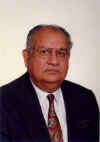|
|
||||
|
Ambassador of Nepal Ambassador of Pakistan Ambassador of Sri Lanka
History Made Easy South Asian Memories
|
|
|
||
|
the-south-asian.com December 2000 |
||||
|
Page 1 of 2
Mr. Naresh Chandra Ambassador of India to the
U.S.
The most challenging period in life The best and the most challenging period was at the District magistrate level in the IAS - the time spent in the field, close to the people whose welfare one was entrusted with – and that is decidedly also the most human content to the job. The contact with people is much less in the Headquarters – where it is a different scene. The most exciting job, however, was as a Cabinet Secretary. One got the opportunity to work with very fine people – Secretaries to the Government of India. Main issues faced in the U.S. ‘Living in interesting times’ is how I would describe my tenure here. Something or the other has always been happening. There was a lot of interaction on the Comprehensive Test Ban Treaty when I first arrived here. 1997 was a ‘feel good’ time – we were celebrating 50 years of Independence - there were series of functions and events – in fact we had more functions in the U.S. than in India. The major challenge came in May 1998 - dealing with the nuclear test. I remember going from one studio to another – TV, radio, and press – in addition to dozens of meetings in the Senate and the Congress. That was the most difficult and a very challenging period of my tenure here. Then began the rounds of discussions between Indian delegation, led by Jaswant Singh, and the U.S. delegation led by Talbot. I was present in every meeting and throughout. We saw the scene develop from a very tense dialogue into a very friendly and frank exchange of views. This brought about stability and progress in a positive direction in our relations with the U.S. The Prime Minister’s visit in September 1998 was also an important one. It dissipated the demonising of India that had gone on before his arrival. People saw him and heard him speak. His statement that "India and the U.S. can be natural allies in the 21st century" struck a chord in the U.S. administration. President Clinton’s visit to India and then the return visit of the Indian Prime Minister put a feel on it. I witnessed a very fine chapter in the Indo-U.S. relations. A specific instance that I will remember of my tenure, is the establishment of Gandhi Memorial - [Mahatma Gandhi’s statue] – in front of our Chancery building in Washington DC – and the way it was accomplished against heavy odds. We were able to have it up just in time to have it dedicated by the Prime Minister of India in the presence of the president of the United States on 16 September 2000. It was a great moment – for South Asians and Americans. I also received many messages from our friends in Pakistan – and the Pakistan Ambassador congratulated me and expressed her happiness at the establishment of the statue. Role of Indian American community & Indo-U.S. relations The Indian American community has played a very important role in Indo-U.S. relations. They have helped accomplish two things. One, a greater breadth and richness of engagements between Indians and Americans. Secondly, they dispelled the old image of Indians as poor and poverty stricken, without appearing to be Maharajahs. There is a new generation of Indians here – successful executives, intelligent individuals with technological skills. Both these factors changed the Indian image to that of a more modern, vigorous and intelligent people. These success stories also generated a quest for reforms in India – because questions were raised that if Indians can be successful outside India then why doesn’t our system allow them to be equally productive in their own country. We tried our best to maximise contacts between successful Indian technocrats here and our Ministers and opinion-makers back home, and also promoted industry to industry contact in a very big way. Many Ministers in India have now inducted Indian Americans in the Advisory Committees set up in Information Technology, Telecommunications and other areas. Indian Americans have also funded and established Chairs in Universities at Berkeley, Santa Cruz, New York and Chicago. Basically it is the Indian State that has asserted itself and its commitment to democracy; to rule of law; to a pluralistic, tolerant and a purposeful society not having militarist ambitions, and reinforced its commitment to a development oriented society. |
||||
| Copyright © 2000 [the-south-asian.com]. Intellectual Property. All rights reserved. | ||||
| Home |
